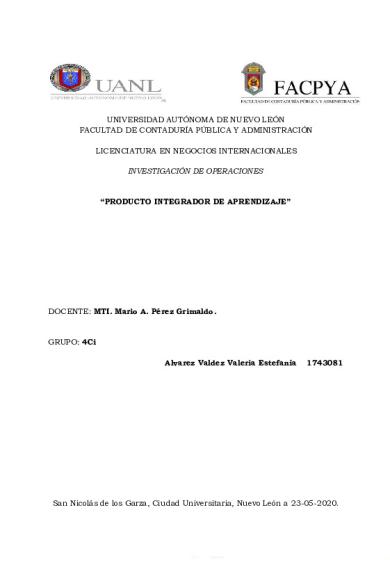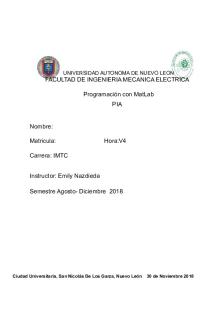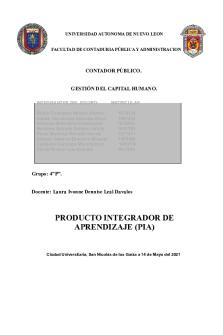PIA Operaciones PDF

| Title | PIA Operaciones |
|---|---|
| Author | Vale Álvarez |
| Course | Investigación De Operaciones |
| Institution | Universidad Autónoma de Nuevo León |
| Pages | 9 |
| File Size | 240.1 KB |
| File Type | |
| Total Downloads | 123 |
| Total Views | 461 |
Summary
Warning: TT: undefined function: 32 UNIVERSIDAD AUTÓNOMA DE NUEVO LEÓN FACULTAD DE CONTADURÍA PÚBLICA Y ADMINISTRACIÓNLICENCIATURA EN NEGOCIOS INTERNACIONALESINVESTIGACIÓN DE OPERACIONES“PRODUCTO INTEGRADOR DE APRENDIZAJE”DOCENTE: MTI. Mario A. Pérez Grimaldo.GRUPO: 4CiAlvarez Valdez Valeria Estefan...
Description
UNIVERSIDAD AUTÓNOMA DE NUEVO LEÓN FACULTAD DE CONTADURÍA PÚBLICA Y ADMINISTRACIÓN LICENCIATURA EN NEGOCIOS INTERNACIONALES INVESTIGACIÓN DE OPERACIONES
“PRODUCTO INTEGRADOR DE APRENDIZAJE”
DOCENTE: MTI. Mario A. Pérez Grimaldo.
GRUPO: 4Ci Alvarez Valdez Valeria Estefanía
1743081
San Nicolás de los Garza, Ciudad Universitaria, Nuevo León a 23-05-2020.
INDEX
SUMMARY.................................................................................................................3 INTRODUCTION........................................................................................................4 H&M INVENTORY CASE...........................................................................................5 CONCLUSION............................................................................................................8 REFERNCES..............................................................................................................9
2
SUMMARY
Hennes & Mauritz AB or simply H&M is a chain of clothing, accessories and cosmetics stores with devices in Europe, the Middle East, Africa, Asia and America. It has 4,700 own stores spread across 69 countries and employs approximately 161,000 people (2017). It also sells clothing by catalog and through the Internet in 44 countries. The H&M group is one of the largest fashion companies in the world, making it one of the largest in Sweden as well. The secret to the success of H&M, can be attributed to their “fast fashion” model. As summarized by Forbes, fast fashion is the idea of moving large volumes of merchandise from the designer table to the showroom floor in the shortest amount of time possible. The retailer can achieve this goal by having higher merchandise turnover and by constantly resupplying the product pipeline with the latest fashion trends. H & M’s model also requires a solid marketing team that can quickly determine what their target demographic desires and implement the necessary changes into the supply chain. Of course, the backbone of fast fashion is its low prices, and fast fashion has also been pejoratively labeled “cheap chic,” because H&M clothes are notorious for their “disposable” quality and easy to manufacture nature. In the beginnings of 2018 they went through an inventory problem from which they had the biggest loss of money, and we will talk about their ways to solve it, and the changes they made for good to help them prevent this kind of problems to arise again.
3
INTRODUCTION H&M Group reaches fashion lovers across the globe and has come a long way since the first Hennes store opened in the Swedish city Västerås back in 1947. 1947, Persson opens a new womenswear store in Västerås, Sweden. He calls it Hennes, Swedish for “Hers”. The 1950s closes with the opening of a flagship store in the first of five skyscrapers built in the Hötorget area in central Stockholm. In 1968, Hennes acquires the Stockholm-based hunting apparel and fishing equipment retailer Mauritz Widforss, and the name is changed to Hennes & Mauritz. This is the start of offering of men's and also children's clothing, leading to H&M offering clothes for the entire family. In 1974, Hennes & Mauritz is listed on the Stockholm Stock Exchange. The same year, the stores are rebranded with the abbreviation “H&M”. In the late 1970s, modern teenagers get their own version of H&M as the Impuls concept is launched, inspired by U.S. denim stores. In 2010, H&M for the first time launches a full fashion collection made from sustainable materials. H&M Beauty is on everybody's lips, as a full range of specially designed makeup, body care and hair styling products enter the scene in 2015. Afound was launched in 2018 with the first stores in Sweden and online. Afound is a new marketplace selling discounted fashion and lifestyle products, with both external and the H&M group’s own brands, offering a wide range of well-known, popular brands for both women and men. In 2019, H&M became the first big fashion brand in the world to provide detailed information about the factory and material for individual garments in-store and online. H&M Group increased its ownership in Sellpy, an e-commerce platform for second-hand where the H&M group is now the main owner. But even though H&M is a firm that has been building itself at a slow but constant way there was a time where they faced an inventory problem who almost causes their closure; so now we will learn about the things H&M did to fix it and the models of solutions they could have applied.
4
H & M $4 BILLION INVENTORY CHALLENGE H&M, the world’s second-biggest fast-fashion retailer, had a problem that was only becoming more visible. With an increasingly outdated business model, the retail group was struggling with customer engagement with its core brand. As a result, H&M’s net profit has been in decline every year since 2015, and in its first-quarter report in 2018, the group disclosed that its inventory levels had risen to $4 billion. H&M’s problems, however, are not new, there were other brands like Diesel and Arcadia group who had filed for bankruptcy in the United States as agile onlineonly brands such as Boohoo.com and Fashion Nova, and low-cost retailers such as Primark, make the competition even fiercer. In response to its inventory challenge, H&M made up a plan to invest and improve in four key areas: • • • •
Digital platforms — from online shopping to loyalty programmes; Infrastructure of supply chain and logistics; The convenience of its products and physical stores; Future-proofing its business operations to avoid repeating the same mistakes.
After they implemented this plan there were signs that H&M’s investment was paying off: sales increased 11% in the first half of 2019 and its customer loyalty programme now counts over 43 million members. However, the company’s inventory levels remained stubbornly high at $4 billion and its profits slid 11% in the first half of 2019 compared to a year earlier. Here are four things the global fashion retailer did to right the ship: •
A new venture may provide H&M somewhere to unload its excess inventory. The company will launch a new off-price brand known as Afound in 2018. Afound will be an off-price marketplace offering products from fashion and lifestyle brands, both external brands and those from the H&M group. Its first stores and a digital marketplace will open in Sweden to start with.
5
•
H&M is investing a lot in automated warehouses. Three new highly automated logistic centers with significantly increased capacity and efficiency and faster lead times will be introduced during the year. "By optimizing our logistic network, we will also be able to increase product availability and further ahead reduce stock levels in relation to sales," said Persson.
•
H&M is also investing a lot in advanced analytics and artificial intelligence and says it sees "a very big potential here across-the-board from assortment planning to supply chain and sales." The areas it's focusing investments on are trend detection, quantification and allocation, price management and personalization. Ongoing projects in this field already show sales uplifts.
•
H&M says it now has a robust and scalable tech foundation that will enable faster development of consumer-facing apps and digital experiences.
The big problem that stores like H&M face it’s their problem to adapt and invest in their online platforms and last-mile operations, which improve customer experience as well as better positioning the retailer to compete alongside successful online-only platforms. Another problem was the difficult time they were having controlling their supply chain, having a supply chain risk, which is the likelihood of a disruption that would impact the ability of the company to continuously supply its products, and inventory management, and they were kind of stuck in its ways when it comes to design cycles and retail models. Customer data — which H&M has in spades — is only valuable to a retailer if it makes use of it and has the flexibility in its logistical operations to act on its findings. As part of its investment in AI, H&M is piloting a number of tools that aren’t necessarily futuristic but help to collect and manipulate data about its stores, so as to gain a global-yet-local understanding of factors such as shopping behavior, weather, and specific locations of its shops. Much like the question of verticalizing versus outsourcing supply chain, retailers need to choose between buying or building their AI capabilities. While H&M is choosing to buy, for example, Zara is conducting research alongside MIT.
6
There is also the potential for internal cultural conflicts in a fashion company turning to an AI team to voice concerns or ideas on the design side of its operations. H&M will use analytics to track what merchandise is bought and returned to each store to determine what resonates well with local customers. This will help the company customize its store assortments to ensure that it is stocking exactly what its customers want. The model that I’d have a better capacity planning so they can maintain system balance, re-design their frequency of capacity additions or reductions, and the use of external capacity. I´d focus on the frequency of the capacity additions and put more into the forecasting techniques and the use of decision trees to evaluate capacity alternatives it would be really beneficious to them. The DMAIC model which is an acronym for Define, Measure, Analyze, Improve, and Control improvement, would also be one way to help them.
7
CONCLUSION By doing the research for this project I could realize that problems related to logistics, inventory, supply chain are very common in small or large companies but they are usually fast to react and solve the problem at hand, which stops the issue to extend to other parts of their firms. The problem that H&M had was making it lose as much as $4 billion dollars for keeping more than enough inventory without selling it and this was bringing down the sales so they had to make some changes in their operations to try to correct the problem and prevent it to happen again. The control over your systems and merchandise its essential to have an overview of the situation of the firm, so in case something it´s starting to fail they can go to where the problem is and fix it; having personnel in charge of this areas its important too. I enjoyed doing research about this and learning about how different companies dealt with similar problems or even the same problems, but the way they managed to correct or fix theirs issues in every one was something from which I learned different points or ways to see a solution.
8
REFERENCES Jacob, F. R. (2013). Operations and Supply Chain Management The Core(3 ed.). New York, NY: McGraw-Hill/Irwin. Paton, E. (2018, March 27). H&M, a Fashion Giant, Has a Problem: $4.3 Billion in Unsold Clothes. Retrieved from https://www.nytimes.com/2018/03/27/business/hm-clothes-stock-sales.html H&M Is Trying To Combat Inventory Problem With More Aggressive Discounting. (n.d.). Retrieved from https://wellmadeclothes.com/articles/HMMoreAggressiveDiscounting/ Team, B. F. (2019, August 2). The BoF Podcast: Inside H&M's $4 Billion Inventory Challenge. Retrieved from https://www.businessoffashion.com/articles/podcasts/the-bof-podcast-insidehms-4b-inventory-challenge Phuong, A. (2018, December 19). Industry Analysts Are Concerned About H&M's Future. Retrieved from https://www.styledemocracy.com/hm-inventoryproblems/
9...
Similar Free PDFs

PIA Operaciones
- 9 Pages

PIA Ingles - pia
- 12 Pages

PIA Literatura
- 9 Pages

PIA inmunologia
- 4 Pages

PIA Carrito
- 18 Pages

Pia matlab
- 22 Pages

Bioetica Pia
- 32 Pages

PIA - trabajo
- 14 Pages

PIA Individual
- 9 Pages

PIA Eticaycult
- 10 Pages

PIA Lógica
- 11 Pages

Pia - presentación
- 5 Pages

PIA Contexto
- 16 Pages
Popular Institutions
- Tinajero National High School - Annex
- Politeknik Caltex Riau
- Yokohama City University
- SGT University
- University of Al-Qadisiyah
- Divine Word College of Vigan
- Techniek College Rotterdam
- Universidade de Santiago
- Universiti Teknologi MARA Cawangan Johor Kampus Pasir Gudang
- Poltekkes Kemenkes Yogyakarta
- Baguio City National High School
- Colegio san marcos
- preparatoria uno
- Centro de Bachillerato Tecnológico Industrial y de Servicios No. 107
- Dalian Maritime University
- Quang Trung Secondary School
- Colegio Tecnológico en Informática
- Corporación Regional de Educación Superior
- Grupo CEDVA
- Dar Al Uloom University
- Centro de Estudios Preuniversitarios de la Universidad Nacional de Ingeniería
- 上智大学
- Aakash International School, Nuna Majara
- San Felipe Neri Catholic School
- Kang Chiao International School - New Taipei City
- Misamis Occidental National High School
- Institución Educativa Escuela Normal Juan Ladrilleros
- Kolehiyo ng Pantukan
- Batanes State College
- Instituto Continental
- Sekolah Menengah Kejuruan Kesehatan Kaltara (Tarakan)
- Colegio de La Inmaculada Concepcion - Cebu


